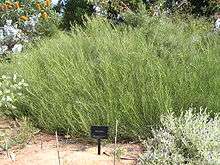Acacia ashbyae
Acacia ashbyae, commonly known as Ashby's wattle, is a species of wattle that is endemic to Western Australia.[1]
| Ashby's wattle | |
|---|---|
 | |
| Scientific classification | |
| Kingdom: | Plantae |
| Clade: | Tracheophytes |
| Clade: | Angiosperms |
| Clade: | Eudicots |
| Clade: | Rosids |
| Order: | Fabales |
| Family: | Fabaceae |
| Clade: | Mimosoideae |
| Genus: | Acacia |
| Species: | A. ashbyae |
| Binomial name | |
| Acacia ashbyae | |
 | |
| Occurrence data from AVH | |
Description
The wattle grows as a rounded, dense and spreading shrub, up to 2 metres (7 ft) high and 3 m (10 ft) wide. The narrow, flat, pale green phyllodes are 30 to 90 millimetres (1.2 to 3.5 in) long by 1 to 3 mm (0.039 to 0.118 in) wide, with new growth covered in white hairs. It produces bright yellow, cylindrical flowers, about 10 mm (0.39 in) long, on short racemes from July to September.[1][2]
Taxonomy
The species was first formally described by the botanist Bruce Maslin in 1974 as part of the work Studies in the genus Acacia - 2 - Miscellaneous new phyllodinous species published in the journal Nuytsia. It was reclassified in 2003 by Leslie Pedley as Racosperma ashbyae then transferred back to the genus Acacia in 2006.[3]
The specific epithet ashbyae honours botanical illustrator and plant collector Alison Ashby.[4]
Distribution and habitat
It occurs on sandy and loamy soils along roadsides, on rocky rises and sandplains in the Avon Wheatbelt, Geraldton Sandplains and Yalgoo IBRA bioregions.[1]
See also
References
- "Acacia ashbyae". FloraBase. Western Australian Government Department of Parks and Wildlife.
- Sheather, Warren; Gloria Sheather. "Acacia beckleri".
- "Acacia ashbyae Maslin". Atlas of Living Australia. Global Biodiversity Information Facility. Retrieved 5 September 2018.
- Robertson, Enid (2007). "Ashby, Alison Marjorie (1901–1987)". Australian Dictionary of Biography, Volume 17 (MUP). National Centre of Biography, Australian National University. Retrieved 29 May 2014.
| Wikimedia Commons has media related to Acacia ashbyae. |